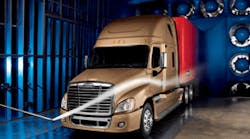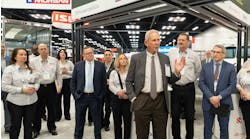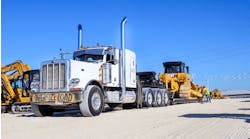CHARLOTTE, NC. Freightliner Trucks launched the Cascadia, a Class 8 truck that is not only engineered to accommodate EPA ’07 and ’10 engines, but boasts a 3% boost in fuel economy over previous models and generous driver amenities in a totally redesigned cab. The Cascadia is in production now and will be delivered to customers by the end of this year.
The Cascadia replaces the Columbia/Century but the OEM said it will continue producing those models “for the foreseeable future.”
The new model’s fuel economy gain was achieved thanks to its aerodynamic design, which cuts drag by 20% over previous models. Freightliner LLC said engineers spent 2,500 hours developing the Cascadia in its custom wind tunnel built specifically for Class 8 vehicles. The Cascadia is the first truck built and engineered using this facility.
“Our wind tunnel was constructed expressly for this kind of new model development,” said Chris Patterson, president & CEO of Freightliner LLC. “Apparently tiny tweaks in the design made possible by our unlimited use of our own facility can save owners hundreds of dollars in fuel consumption over the life of their truck.”
The OEM said the Cascadia will easily accept EPA ’07 emission engines and adapt “with little change” to the upcoming EPA ’10 standard. The tractor has a larger front-end to accommodate a larger capacity radiator—up to 1,755 sq.-in.—to sufficiently cool EPA ’10 engines. The Cascadia was built to be optimized with the all-new EPA ’10-ready Detroit Diesel heavy-duty engine family, which will debut later this year. The tractor also features an expandable electronic platform that could accommodate ’10 technology, including SCR (selective catalytic reduction).
The Cascadia also will offer a fully integrated battery-powered auxiliary HVAC system to save fuel and an engine cooling system that minimizes engine fan and air-conditioning compressor on-time, the OEM said. It will be available early next year.
Freightliner said the Cascadia boosts payload capacity by cutting the truck’s weight, using an aluminum cab instead of steel and making the hood, bumper and quarter fenders lighter. Enhancements to ensure the Cascadia stays out of the shop include: improved diagnostics, low-maintenance HVAC system, breakaway side extenders, roped-in windshield that can be changed within minutes, extended-life headlamp bulbs, and easy access to the engine with accessory components mounted to it.
Driver satisfaction and productivity were a major design focus, evident by the completely redesigned cab, featuring more room, automotive styling, ergonomic controls, and plenty of lighting and storage space. The seats are larger, with more room between the seats. The all-new cab has larger door openings, more head and belly room, and easier-to-use switches and climate controls.
Freightliner has cut the noise and vibration with double door and window seals, improved engine and cab mounts, additional insulation and a hydraulic clutch to offer reduced.
The tractor comes standard with the 455-hp Detroit Diesel Series 60 engine, with an MBE 4000 with ratings of 370 to 450 hp and Caterpillar C15 with ratings from 435 to 550 hp available as options. An EatonFuller manual transmission is standard, with UltraShift and AutoShift transmissions available as options.
Other key specs include:
- GVWRs of 35,000 to 71,000 lbs. with a GCWR of 92,000 lbs.
- Standard front taperleaf suspension rated at 12,000 lbs.; optional spring suspension rated at 14,600 lbs.
- Standard rear AirLiner suspension rated at 40,000 lbs.; optional AirLiner suspension rated at 21,000 lbs.
For more information, go to www.FreightlinerTrucks.com or call 800-FTL-HELP.



